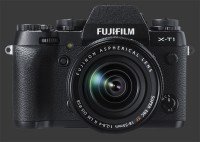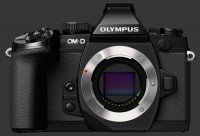Olympus OM-D E-M1 Review
Olympus OM-D E-M1 Introduction
The Olympus OM-D E-M1 is the flagship Micro Four-Thirds Mirrorless Digital Camera from Olympus. As the second model in the OM-D lineup, the E-M1 is now freezeproof down to -10C and features a new 2.4 megapixels EVF.
This digital camera is built around an all new 16 megapixels Four-Thirds sensor with a maximum ISO of 25600, 10 FPS full-resolution continuous drive and 1080p HD video capture. It features built-in image stabilization, dual control-dials and a dual-axis digital level. The new sensor incorporates built-in Phase-Detect AF, a first from Olympus, and does not have an anti-alias filter in front of it.
The E-M1 provides a huge number of features, including AEB up to 7 frames, built-in HDR, Time-Lapse and Multiple Exposure. The offers plenty of controls in one of the most flexible interface ever. Dials, button and behavior can be customized and fine-tuned. The innovative Live-Time and Live-Bulb modes, introduced with the E-M5, are fully retained too.
Video features of the E-M1 are extremely sophisticated including Program, Aperture-Priority, Shutter-Priority and Manual exposure as well as Art Filters. Video focus modes include continuous autofocus (AF-C), subject-tracking autofocus and direct manual-focus (DMF). Stereo sound is recorded via the built-in microphone or an external one which connects the the hot-shoe's accessory port.
This digital camera review covers the usability, performance and image quality of the Olympus O-MD E-M1.
Olympus OM-D E-M1 Features
Sensor
- 16 Megapixels CMOS Four-Thirds sensor
- No Anti-Alias Filter
- Micro Four-Thirds lens mount
- 5-Axis Sensor-Shift image stabilization
- Built-in ultra-sonic dust-reduction
Exposure
- ISO 100 to 25600 sensitivity, 1 or 1/3 EV steps
- Auto ISO, customizable limit from 200 to 25600
- 1/8000 - 60s Shutter-speeds, Bulb up to 30 minutes, 1/3, 1/2 or 1 EV steps
- PASM Exposure modes
- Program-Shift in P mode
- Exposure-Compensation, ±5, 1/3, 1/2 or 1 EV increments
- Exposure-Shift, ±1, 1/6 EV increments
- Multi-Segment, Center-Weighed, Spot, Shadow Spot and Highlight Spot metering
- Auto-Exposure Bracketing, 3, 5 or 7 frames, max 3 EV steps except 2 EV for 7 frames
- Built-in HDR, 2 blending levels
- Flash-Compensation, ±3, 1/3 or 1/2 EV steps
- Auto, Redeye, Forced, Off, Slow-Sync+Redeye, Slow-Sync, Rear-Sync and Manual flash modes
- Manual flash power between full and 1/64th power
- Remote-Control flash
Image Parameters
- AutomaticTwo types: Normal and Warm-preserving., 7 presetsSunny, Shade, Cloudy, Incandescent, Fluorescent, Underwater, Flash, Kelvin and Custom White-Balance, 4 memories
- White-balance fine-tuning along 2 axis in 15 steps
- Digital white-balance preview
- Optional One-Touch custom white-balance
- Optional Long-Shutter Noise-Reduction
- Optional High-ISO Noise-Reduction, 3 levels
- 14 Color and 2 B&W Picture Modes
- Adjustable contrast, sharpness, saturation, 5 steps each
- Adjustable gradation, automatic or 3 levels
- Adjustable tone curve, 15 steps for highlights and 15 steps of shadows
- sRGB or Adobe RGB color space
Focus
- Single-shot (AF-S), continuous (AF-C), direct manual-focus (DMF), Tracking AF or MF
- 81-area Contrast-Detect AF system, automatic or manual point-selection
- 37-point Phase-Detect AF system, used with Four-Thirds lenses only
- Manual Focus-Assist, 5-14X magnification
- Optional Focus-Peaking
- Optional Full-Time AF
- Optional Face-Priority
- Optional Bulb focusing
- Optional AF-Assist lamp
- Optionally reset lens focus to infinity
- Controllable focus-ring direction
Drive
- 10 FPS Continuous drive, 41 RAW files or 95 JPEG images
- Time-Lapse, 1-999 frames, 1s-24h interval, 0-24h delay, optional video
- Multiple-Exposure, 2 frames, optional automatic gain and composition overlay
- Self-timer, 2s or 12s
Video
- 1920x1080 @ 30 FPS Video using AVCHD codec
- 1280x720 @ 60 FPS Video using MPEG-4 codec
- Program, Aperture-Priority, Shutter-Priority and Manual video exposure
- Automatic and Art-Filter video modes
- Optional stereo sound with built-in microphone
- Optional external stereo microphone via accessory port
Display & Viewfinder
- 0.5" EVF, 2.4 Megapixels
- Eye-start sensor
- Digital-level, 2-Axis
- Tilting 3" Touchscreen LCD, 1 Megapixel
- Optional Live-Histogram
- Optional guidelines, 5 types
- Adjustable brightness, 15 steps
- Adjustable color temperature, 15 steps
Controls
- Dual control-dial
- 8 Customizable buttons
- AE-L/AF-L hold and toggle modes
- Customizable AE-L metering mode
Output Processing
- 4:3 Native aspect ratio
- 3:2, 16:9, 1:1 and 3:4 cropped aspect ratios
- 8, 5, 3, 2 and 1.2 megapixels modes
- JPEG, RAW, RAW+JPEG capture
- 4 JPEG Compression levels
- Optional vignetting correction
Connectivity
- Hot-Shoe for external lighting
- HDMI (1080i) output
- A/V (NYSC / PAL) output
- USB 2.0 connectivity
Misc
- Weather-sealed body
- Freezeproof down to -10C
- Built-in WiFi
- SDXC memory
- Lithium-Ion battery
- Customizable battery warning
- Customizable DPI settings
Olympus OM-D E-M1 Usability - How easy is it to use?
The Olympus OM-D E-M1 has a distinctively angular design with a large viewfinder hump hosting the EVF, hot-shoe and accessory-port. It also has a deep yet narrow hand-grip . The camera feels solid in hand with a good weight. Even the LCD hinge is sturdy and Olympus managed to make it weather-sealed.
The grip offers good purchase which is particularly important when using heavy lenses. The OM-D E-M1, being designed to take full-advantage of Four-Thirds lenses via an Olympus adapter, looks disproportionately small when attached to a bright or long telephoto lens. Note that the Olympus Four-Thirds to Micro Four-Thirds mount adapter is weather-sealed and allows the whole system to be used in inclement weather.

With small Micro Four-Thirds lenses, the E-M1 rarely feels heavy though, so it can deliver on the promise of a relatively compact camera with a professional feature-set. Only a single other mirrorless, the recently reviewed Fujifilm X-T1
Fujifilm X-T1 offers similar environmental protection along with professional ergonomics.
There are two unmarked and customizable buttons at the front of the E-M1. Each of these can be assigned one of 24 functions, probably the most on any camera. These include several functions assigned elsewhere, plus a few exclusive ones like DOF-Preview, One Touch Custom WB, MF-Assist, Digital Level and Peaking.
There is no space to spare on the top-plate of this mirrorless camera. From edge-to-edge, including all over the grip, there are mechanical controls and a hot-shoe with accessory-port. Buttons are all labelled here but this is not going to correspond to actual functions when they are customized.

The left shoulder has two semi-circular buttons elevated above the rotating power-switch. These buttons work with both control-dials on the opposite end of the camera. When the upper-half gets pressed, the front control-dial selects between HDR and AEB options, while the rear dial cycles over drive modes. When the lower-half is pressed, the front dial cycles over metering modes and the rear one over focus modes. The power-switch has a strong detent and is nicely protected from accidental knocks by the elevated buttons and viewfinder hump.
The relatively tall EVF bump houses a stereo microphone plus the hot-shoe. Olympus designed the accessory-port to require a certain height, otherwise the E-M1 would not have to be so tall. To the right of the EVF housing, there is 9-position mode-dial with strong detents and a central button which locks it. The lock must be released for the dial to turn. Given how good the detents are, it seems unnecessary.
The traditional Exposure-Mode dial offers standard PASM modes, a fully Automatic one, 3 positions for different scenes and effects, plus a dedicated Movie mode. Manual mode hides two Olympus exclusive: Live-Bulb and Live-Time. Both these modes keep the shutter open for up to 30 minutes. The former requires the shutter to be held during the whole exposure, the latter does not. In either case, the E-M1 shows a progressing exposure on the LCD which is refreshed at predefined intervals. This is incredibly useful for light-painting and fireworks.
Dual control-dials are located on the top of the Olympus OM-D E-M1. Both dials have moderate detents and are placed comfortably within reach. The front control-dial has a standard two-stage shutter-release in its center. It has a short travel and a very soft halfway point. This makes photographing without shaking the camera easier but may cause accidental shots from time to time.

As any high-end camera would have it, dual control-dials allow to directly control manual exposure. One dial sets the aperture, the other one shutter-speed. Which is which is configurable. In semi-automatic modes, either dial can set the exposure-parameter. The remaining dial can be redundant, set EC or FC. Ideally, it could control the third exposure-parameter, ISO. Unfortunately, the non-redundant options are dangerous, since they easily allow accidental changes to exposure.
Olympus introduced 2x2 Controls with the OM-D E-M5 and those are carried over to the new E-M1. This refers to having dual-control dials plus a two-position switch at the back of the camera. When the switch is set to the 1 position, control-dials always work as configured. When set to the 2 position, things get real complicated. There are 5 modes to choose from: Two of these override the control-dials to set ISO and WB; Two override Fn2 and Video-Record for the same purpose; and the last uses the switch to select between two focus modes. For all these possibilities, the E-M1 becomes quite modal and one always has to remember which position the switch is at before touching anything.
An additional setting decides if the position of the switch changes the functions of the two button on the left shoulder of the camera. When enabled, HDR/Drive toggles AEB and AF/Metering controls Flash Mode and Flash Compensation. While powerful, this system is complex and controls are too coupled to make much sense.
There are two buttons occupying prime real-estate between the control-dials. One controls the tone-curve which is settable independently for shadows and highlights in 15 steps. The other starts recording video. Luckily, both buttons can be reassigned and they really should. EC and ISO are the ideal candidates here among the same 24 options as for the 2 function buttons on the front of the camera. This makes the Olympus OM-D E-M1 operate modelessly and reduces chances of inadvertently changing exposure.

The back of the E-M1 is really busy. A 3" touchscreen LCD with 1 megapixel of resolution occupies over half the surface. It is mounted on a hinge that tilts up 90° or down 45°. This is useful to frame a scene at odd angles but quite unnecessary as this camera offers built-in WiFi, allowing to frame freely using another device.
The center-piece so to speak is the 2.4 megapixels EVF with 0.74X magnification. This viewfinder is extremely sharp and looks huge. It is bigger than the OVF of most full-frame DSLRs. It shows contrast naturally and has an impressive dynamic-range. Users can choose between an extra-large view with overlays or one that is still large yet shows statu information under the preview. Other customization options are available, with a clever one that shows the horizontal Digital-Level when the shutter-release is pressed halfway. A dual-axis Digital-Level overlay is available too.
An essential Eye-Start sensor automatically switches between the EVF and LCD when placing your eye close to the viewfinder. A button toggles the LCD between preview and status display. This provides a nice overview of key camera settings. There is an interactive version of the same display, called Super Control Panel, which can be invoked by pressing the OK button.
The refresh rate of the EVF and LCD is fluid. Both displays show movement with barely any lag. As light levels drop, the view slowly becomes more grainy. In Manual mode, both display are Exposure-Priority, showing an accurate preview of exposure as settings are changed. Unfortunately, this is not true in any other mode where the E-M1 shows a bright image regardless of exposure.
Right next to the EVF, the AE-L/AF-L button is surrounded by the two-position switch described above in this review. This button can activate any of 24 functions, just like other customizable ones. Additionally, users can select any metering mode to lock exposure with. At the very upper-right corner of the camera, there is another customizable button which is easily accessible.
The Info button cycles over display options on the LCD or EVF, whichever is active at the time. Skipping over the 4-way controller, the Menu, Playback and Delete buttons operate just as expected.
The 4-way controller has a central OK button. Pressing OK activates either the Super Control Panel or the Live Control menu. When both are selected for the current mode, Info toggles between the two. Both offer control over plenty of parameters. The SCP includes several mode while being slightly more complicated to navigate. The directional buttons move around the focus-area by default. Optionally, Right and Down can be customized instead.

This digital camera feels very solid with a confidence-inspiring weight. Even the memory and battery doors are sturdy. At the bottom there is a metal tripod socket which is neither inline with the optical center not the physical center of the camera.
The Olympus OM-D E-M1 offers the most customization options of any camera which quickly gets complicated. While default assignments are less than ideal, the E-M1 can be customized into a really efficient digital camera. With so many settings to choose from, it certainly seems overwhelming at first though.
 |
Please Support Neocamera
All information on Neocamera is provided free of charge yet running this website is a huge endeavor. Purchases made via affiliate links found throughout the site help keep it running and up-to-date. There is no additional cost to you, so please consider buying via these links to our affilates:
Thank you for your support!
Olympus E-M1 Highlights

Sensor-Size: 17 x 13mm

Actual size when viewed at 100 DPI
| 16 Megapixels Mirrorless | ISO 100-25600 |
| Micro Four-Thirds Mount 2X FLM | Shutter 1/8000-60s |
| 5-Axis Built-in Stabilization, 4-Stop Improvement | Full manual controls, including Manual Focus |
| 0.50" Built-in EVF 2.4 Megapixels (0.74X) | Custom white-balance with 2 axis fine-tuning |
| Automatic Eye-Start sensor | Spot-Metering |
| 2 Axis Digital Level | Hot-Shoe |
| Weatherproof down to -10C | Stereo audio input |
| Built-in Dust Reduction | Lithium-Ion Battery |
| 10 FPS Drive, 95 Images | Secure Digital Extended Capacity |
| 1920x1080 @ 30 FPS Video Recording | |
| 3" LCD 1 Megapixels |
Updates
2025.11.13

Best Gifts for Photographers in 2025 by Budget
The annual Neocamera Photography Gift Guide updated to 2025. Find great gifts for photographers with any price budget.
2025.07.07

Stellar Photo Recovery Review
Review of Stellar Photo Recovery V12. This Windows and MacOS software can recover photos and videos in a huge number of formats from memory cards, USB drives, SSDs and HHDs.
2025.05.14

Huion Kamvas 13 Gen 3 Review
In-Depth review of the Huion Kamvas 13 Gen 3 Pen Display Tablet for photographers and graphic artists.
2025.01.18

Fujifilm GFX 2025 Lens Roundup
Lens Review roundup of Fujifilm GFX Medium-Format lenses. Quality, performance and handling of the GF20-35mm F/4R WR, GF30mm F/3.5 Tilt-Shift and the GF55mm F/1.7.
2024.11.18

Best 2024 Photography Gifts for Every Budget
Great gifts for photographers and photo enthusiasts selected for every budget among the best products of 2024.
2024.08.07

Eye Protection Tips for Professional Photographers
The four main considerations for professional photographers regarding eyewear.
2024.07.14

Fujifilm X100VI Review
Flagship fixed-lens compact digital camera with a 40 MP sensor and Image-Stabilization, a first for the series. Retro design featuring dual control-dials, plus direct ISO, Shutter-Speed and EC dials. Its hybrid viewfinder can switch between EVF and OVF mode.
2024.05.09

Fujifilm GFX100 II Review
Flagship 102 Megapixels Medium-Format Mirrorless Digital Camera with 8-Stop 5-Axis IBIS, 8 FPS Drive, 8K Video and 400 MP Super-Resolution capture in a weatherproof and freezeproof body with dual control-dials and dual memory-card slots.
2024.04.03

Fujifilm X-T5 Review
Newest Fujifilm flagship boasting a 40 MP APS-C sensor, 5-axis IBIS with 7-stop efficiency, 15 FPS continuous drive, 6.2K Video capture, dual control-dials and dual SDXC UHS-II slots in a sturdy weatherproof and freezeproof body.
2023.11.20

Best Digital Cameras of 2023
Find out which are the Best Digital Cameras of 2023. All the new Mirrorless Digital Cameras from entry-level to high-end professional.
2023.07.10

Fujifilm X-H2 Review
40 Megapixels APS-C Hybrid Mirrorless Digital Camera with 7-stop IBIS. Fastest shutter ever and 8K video capture. Large builtin EVF with 0.8X magnification and 5.8 MP, plus an Eye-Start Sensor. Packed with features and large number of controls in a weatherproof and freezeproof body.
2023.05.07

Sony FE 20-70mm F/4G Review
Review of the unique Sony FE 20-70mm F/4G lens. The optical zoom of this lens spans ultra-wide-angle and medium focal-length coverage, making it one of the most versatile Full-Frame lenses on the market.











